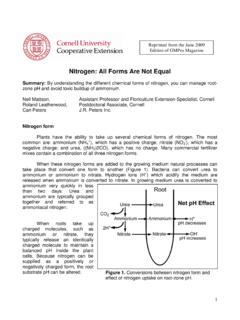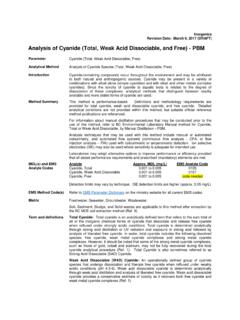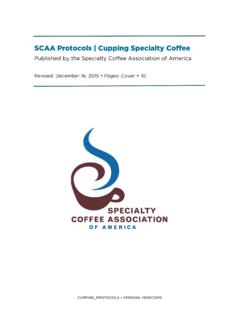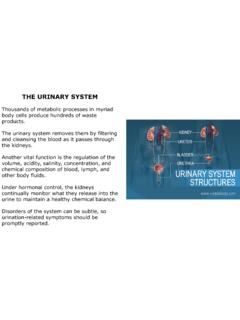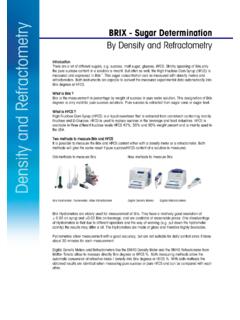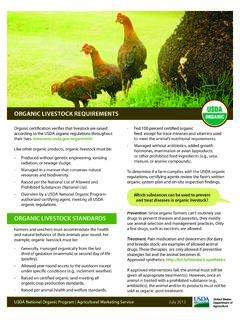Transcription of Acidity and pH of apple juice - cjoliprsf.ca
1 Acidity and pH of apple juiceClaude Jolicoeur197 Aberdeen, Quebec, Quebec, Canada G1R is an important property of apple juices, and is also easily measured. Whether forcidermaking or for blending fresh juice , it is always a good idea to have a measurement of notably, the Acidity of the juice has an influence on:The perceived Acidity in the taste of the fresh juice and of the finished cider: if the acidityis too low, the juice or cider will lack freshness. On the other hand, too much Acidity mayrender the juice or cider too sharp and unpleasant to drink. We need to seek the type of Acidity responsible for the tasting sensation is called total Acidity (or TA) andis easily measured by protection of cider from spoiling micro-organisms: a cider which has a low aciditylevel will be much more susceptible to be spoiled by such type of Acidity that governs this protection is the pH (potential Hydrogen) thatmeasures the concentration of H+ ions in a solution.
2 The pH is related with thebiochemical reactions that occur in the fermenting cider. It is easily measured with a pH-meter or with indicator we can see that the total Acidity is a property which is most useful for blending of fresh juiceand cider, while pH is a property mostly useful in cider biochemistry. These two scales are verydifferent: the pH scale is an inverse logarithmic scale where when the pH is reduced by one unity,the concentration of hydrogen ions is multiplied by ten. The total Acidity is a linear scale where ifthe value is twice as large, the percieved Acidity will also apple juices have a pH between for the more acidic juices and up to about for thejuices that contain very little Acidity .
3 On the TA scale, the Acidity is often expressed as grams perlitre (g/ ) of malic acid. The values measured may range from 1 g/ for the least acidic juices toabout 15 g/ . The total Acidity may also be expressed as a percentage: 1% total Acidity being equalto 10 g/ . In North America, another scale is also often used, which is the total Acidity in tartaricacid equivalent. This is because most Acidity titration kits sold in winemaking supply stores arecalibrated for tartaric acid which is the main acid in grapes. But since in apples the main acidpresent is the malic acid, it makes more sense to use the malic acid scale. To convert the totalacidity number from tartaric acid equivalent to malic acid we need to multiply the grams per litreof tartaric acid by cider making, we usually try to maintain the TA of the blend between and g/ of malicacid, with the lower figure more typical of English cider made with bittersweet apples, while thehigher figure would be more typical of North-American sparkling cider.
4 For fresh juice or forsweet ciders and ice ciders, the Acidity may be higher as the sugar will balance the it was mentioned earlier, the pH is related with the biochemistry of the fermentation. Researchwork was done, most notably by the Long Ashton research station in England during the years1960 to about 1980, to study those aspects. From this research work, we may retain, for practicalcidermaking purposes, the following important guidelines: When the pH is lower or equal to , the Acidity is normally sufficient to protect the ciderfrom the spoilage due to unwanted micro-organisms. If the pH is between and , the Acidity alone would not be enough for protection andthe addition of sulfite (SO2) is recommended to complete the protection.
5 Therecommended dosage of SO2 varies from 50 ppm when the pH is closer to , and up to180 ppm when the pH reaches If the pH of the juice is higher than , it is recommended to lower the pH to byblending or by adding some malic acid, and then to add the recommended SO2 dosage fora pH of has been considerable discussion in the cider making community as to whether we couldsubstitute one of the measurements for the other. In other words, can we use the result of a totalacidity titration to assess the level of protection of a cider? Or, can we use the pH measurementsin blending different varieties when seeking a certain level of Acidity in the juice or in the finishedcider?
6 Before we go further, I need to explain a few basic things about acid solutions. What is called astrong acid is a substance that, when in solution in water, will release one H+ ion for eachmolecule of the acid. We then say it is fully dissociated. And if we know the dilution, we cancompute the number of molecules and thus the mass of acid and the TA; and we can also computethe number of H+ ions and the pH. So there will be a predictable and exact relationship betweenpH and TA for a particular strong acid, and this relationship will be such that when the TA ismultiplied by ten, the pH will be reduced by one unit as this is how the pH scale is defined. Applejuice is however quite different: we are dealing with mostly malic acid, mixed with a few otheracids present in lower concentrations.
7 These acids are organic weak acids that can release eitherzero, one or two H+ ions per molecule depending on the conditions and thus they are only partlydissociated. The difficulty is that we can t predict the extent of dissociation which depends onmany factors (and I will skip these as it would become too complex). So, even if we know howmany molecules of acid we have, we don t know how many H+ ions they will have we can t compute the pH from the TA. Then, the original question now becomes: althoughwe can t theoretically obtain a predictable and exact relationship between pH and TA for applejuice, maybe there could be some sort of empirical relationship, meaning that the extent ofdissociation of the acids would be fairly constant from a sample of juice to there were no definitive answer to this, I started gathering some data points to either confirmor infirm this possibility.
8 Each data point had to give both measurements ( TA and pH) fromthe same sample of juice . I found some in the literature from the following references:Smock, R. M. and Neubert, A. M. (1950), Apples and apple Products, IntersciencePublishers, New York, 486 pages. In Table 38, page 338, there are 4 data points ofcommercial table apple varieties from USA, unspecified origin and , and Wood, (1979), Tasting of Single Cultivar Ciders, in theProceedings of The Second Cider Workshop, 3rd October, 1979, Long Ashton ReasearchStation, UK. 9 data points from English cider , J. C. and Aitken, H. C. (1980), apple juice , in Nelson and Tressler, Fruit andVegetable juice Processing Technology, 3rd edition, AVI Publishing, pp 212-267.
9 In there are 9 data points from table apples grown in British Columbia in the years 1934-45, from Atkinson & Strachan, 1949. And in Table there are 8 data points from testsdone in New England, from Clague & Fellers, , A., The Wittenham Hill Cider Pages ( ). The page CiderApple Data contains a table of 40 data points from the Geneva Station in New York,originally published by D. Downing in Processed apple Products, AVI Van Nostrand,1989. The measurements would probably have been done by the end of the 1970's fromthe apples grown in the Geneva Station. These include cider apples and standard addition to these 70 published data points, I was able to gather quite a number of points fromcider makers in England and North America after making requests throuth the Cider Workshopand the Cider Digest internet discussion forums, which I added to some data points I had takenmyself.
10 This gave me a total of 165 points, taken from different areas in North America andEngland, with time frame ranging from the 1930's to 2010, and from a diversified range of applesvarieties and types. These data points have then been plotted on a semi-log graph. The semi-log was chosen becausethe pH is a logarithmic scale and thus the resulting graph was linear. I was then able to draw abest fit straight line through these points with the slope adjusted so the pH would decrease by oneunit when the total Acidity is multiplied by 10 as per the theory of pH. This is the blue ligne on thegraph. Its equation is:pH = - Ln(TA) / Ln(10)which can also be written:pH = - Ln(TA)Now, it can easily be seen that there is a lot of scatter of the data points around this mean line.
